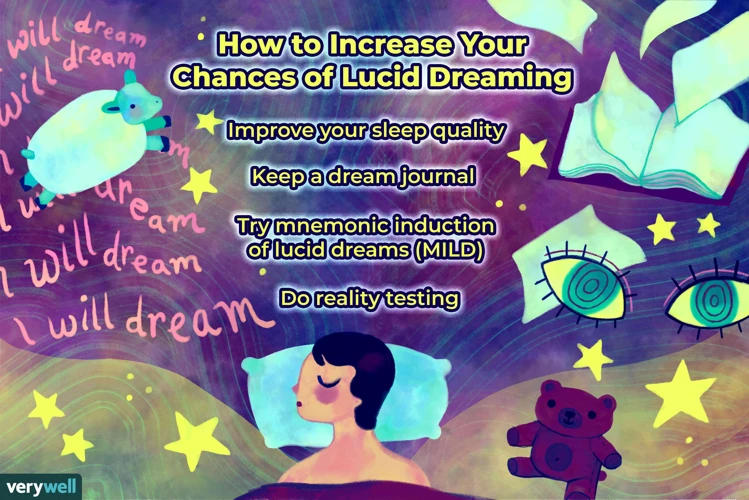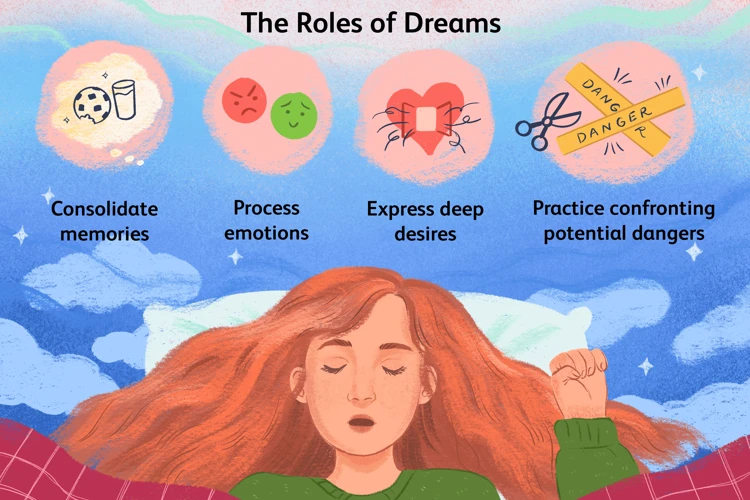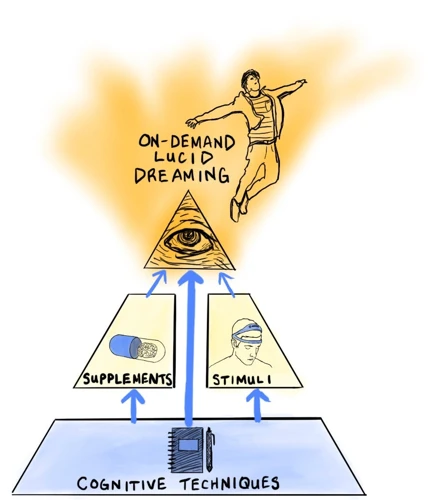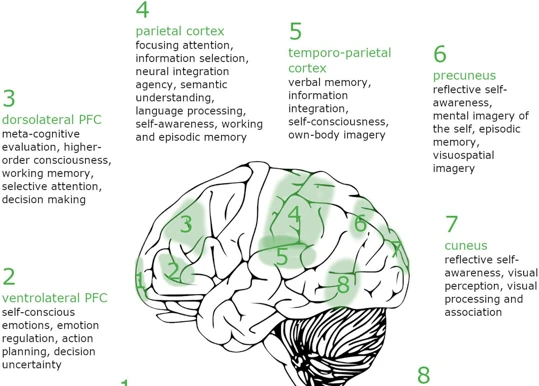Have you ever experienced the sensation of being fully aware and in control within your dreams? Lucid dreaming is a fascinating and enigmatic phenomenon that allows individuals to not only be aware that they are dreaming but also to actively participate and manipulate the dream content. The concept of lucid dreaming has been observed and explored for centuries, sparking curiosity about the inner workings of the brain and the potential applications of this unique state of consciousness. In this article, we will delve into the science behind lucid dreaming, uncovering the neurological basis of this phenomenon, exploring theories on its purpose and benefits, and discussing practical techniques to induce and enhance lucid dreams. Join us on this intriguing journey into the intricacies of the dream world and the mysteries of the human mind.
What is Lucid Dreaming?

Lucid dreaming is a remarkable phenomenon that occurs when a person becomes aware that they are dreaming while still in the dream state. It is like having a dual consciousness, where the dreamer is not only an observer but an active participant in their dreamscape. During a lucid dream, individuals can exhibit self-awareness, critical thinking, and volitional control over their actions within the dream. This state of consciousness allows individuals to manipulate the dream environment, change the course of events, and even interact with dream characters. Lucid dreaming can be an exhilarating and empowering experience, providing an unprecedented level of freedom and creativity to explore the depths of the subconscious mind. Whether it’s flying through the skies, traveling to distant lands, or confronting fears and overcoming obstacles, the possibilities within a lucid dream are virtually limitless. The exploration of personal growth, the potential benefits in therapy, and the power of lucid dreaming in facing nightmares are just some of the intriguing avenues waiting to be explored. So, let’s delve deeper into the realms of lucid dreaming and unlock the secrets of this astonishing state of consciousness. (Link: lucid-dreaming-personal-growth)
The Neurological Basis of Lucid Dreaming

The Neurological Basis of Lucid Dreaming lies in the intricate workings of the brain during sleep. One crucial aspect of lucid dreaming is its connection to REM (Rapid Eye Movement) sleep, the stage of sleep characterized by high brain activity and vivid dreaming. During REM sleep, the brain displays similar patterns of activity to waking consciousness, including activation of the prefrontal cortex, the area associated with decision-making and self-awareness. This activation allows the dreamer to recognize the dream state and achieve lucidity. Additionally, studies have shown that lucid dreaming is associated with increased brainwave activity in the gamma frequency range, which is linked to enhanced attention and cognitive processing. Understanding the neurological mechanisms behind lucid dreaming can provide insights into its potential benefits and applications, such as exploring the possibilities of personal growth (Link: benefits-of-lucid-dreaming-exploring-possibilities) and empowering individuals to confront and overcome nightmares (Link: lucid-dreaming-nightmares-empowerment).
REM Sleep and Lucid Dreaming
REM (Rapid Eye Movement) sleep is a crucial stage of the sleep cycle that is closely linked to the occurrence of lucid dreaming. During REM sleep, the brain becomes highly active, resembling a state of wakefulness, despite the body being in a state of deep relaxation. It is during this stage that dreams are most likely to occur, and it is within these dreams that lucid dreaming can manifest. Research has shown that increased brain activity in the frontal areas, specifically the prefrontal cortex, is associated with the experience of lucid dreams. The prefrontal cortex is responsible for higher cognitive functions, such as self-awareness, decision-making, and logical reasoning. In lucid dreams, this area of the brain becomes more active, allowing individuals to recognize the dream state and exert control over their actions and surroundings. Additionally, the level of brainwave activity during REM sleep is also closely connected to the occurrence of lucid dreams. Studies have found that lucid dreaming is associated with increased gamma-band and alpha-band brainwave activity, which are common frequencies seen during periods of wakefulness and alertness. This suggests that lucid dreaming may involve a unique cortical activation pattern that sets it apart from regular dreams. The intricate interplay between REM sleep, brain activity, and the prefrontal cortex provides valuable insights into the neurological basis of lucid dreaming. (Link: lucid-dreaming-rem-cycle)
The Role of the Prefrontal Cortex
The prefrontal cortex, located in the frontal lobes of the brain, plays a crucial role in the experience of lucid dreaming. This region of the brain is responsible for higher-order cognitive functions such as decision-making, logical reasoning, and self-awareness. During lucid dreaming, the prefrontal cortex becomes activated, allowing individuals to maintain consciousness and exert control over their dream narratives. Neuroimaging studies have shown increased activity in the prefrontal cortex during lucid dreaming, suggesting a direct correlation between its functioning and the awareness within dreams. Additionally, studies have revealed that individuals with greater prefrontal cortex activity during sleep are more likely to have lucid dreams. This suggests that the prefrontal cortex acts as a bridge between the dreaming and waking states, allowing for the integration of consciousness and the manipulation of dream events. Understanding the intricate involvement of the prefrontal cortex in lucid dreaming provides valuable insights into the neural mechanisms underlying this extraordinary phenomenon.
Brainwave Activity during Lucid Dreaming
During the mesmerizing state of lucid dreaming, the brain exhibits distinct patterns of brainwave activity that differ from other stages of sleep. Electroencephalogram (EEG) studies have shown that the brain’s electrical activity during lucid dreaming resembles that of being awake and alert. Specifically, researchers have observed an increase in gamma and beta waves, which are associated with heightened cognitive processing, attention, and focus. This suggests that lucid dreaming engages the brain’s prefrontal cortex, the region responsible for decision-making, self-awareness, and logical thinking. Additionally, alpha and theta waves, which indicate relaxation and creativity, are also present during lucid dreaming. It is believed that this unique combination of brainwave patterns allows for the fluidity of conscious awareness and the ability to exercise control within the dream environment. Further research is still needed to fully understand the intricate interplay of brainwaves and the mechanisms behind lucid dreaming, but the findings thus far shed light on the fascinating neurological aspects of this extraordinary phenomenon.
Theories on the Purpose and Benefits of Lucid Dreaming

Many theories have emerged regarding the purpose and potential benefits of lucid dreaming. One prevailing theory suggests that lucid dreaming serves as a mechanism for creative problem-solving and learning. The enhanced cognitive abilities and freedom of thought experienced during lucid dreams can lead to innovative solutions to real-world challenges. Another theory proposes that lucid dreaming plays a vital role in emotional healing and trauma processing. By consciously engaging with distressing dream scenarios, individuals can better understand and process their underlying emotions, leading to a sense of empowerment and resolution. Additionally, lucid dreaming offers a unique platform for personal growth and self-exploration. It allows individuals to confront their fears, uncover hidden desires, and gain valuable insights into their subconscious mind. The potential benefits of lucid dreaming are vast and span beyond imagination. (Link: benefits-of-lucid-dreaming-exploring-possibilities)
Creative Problem Solving and Learning
Creative problem solving and learning are two fascinating aspects of lucid dreaming. When individuals enter a lucid dream, they have the unique opportunity to harness their imagination and tap into their creativity in a way that is not constrained by the limitations of reality. In this altered state of consciousness, the dreamer can actively engage with the dream environment, experiment with different solutions, and explore novel approaches to problem-solving. This can be particularly beneficial for individuals who are facing challenges or seeking innovative ideas in their waking life. Lucid dreaming provides a safe and immersive platform for exploring new perspectives, testing hypotheses, and pushing the boundaries of what is possible. Additionally, studies have shown that practicing skills and rehearsing specific tasks in lucid dreams can enhance learning and improve performance in real-life scenarios. Through the power of lucid dreaming, individuals can unlock their creative potential and enhance their problem-solving abilities in ways that extend far beyond the confines of their waking reality.
Emotional Healing and Trauma Processing
Emotional healing and trauma processing are significant areas where lucid dreaming can potentially offer valuable benefits. One of the remarkable aspects of lucid dreaming is the ability to confront and work through emotional experiences within the safety of the dream world. When individuals become lucid in a dream, they can consciously explore and engage with their emotions, enabling them to face repressed traumas, fears, or anxieties in a controlled environment. The vividness of emotions experienced in dreams can be instrumental in initiating the healing process. Lucid dreaming provides an opportunity to revisit traumatic events and process them with greater awareness and understanding. Individuals may choose to visualize alternative scenarios, find resolutions, or practice self-compassion and forgiveness. The dream environment acts as a therapeutic space, allowing the dreamer to confront their emotions, gain insights, and cultivate emotional resilience. Research suggests that lucid dreaming can contribute to emotional regulation and reduce the intensity of emotional distress in waking life. While lucid dreaming is not a substitute for professional therapy, it can complement traditional therapeutic methods and become a powerful tool for emotional healing and trauma processing.
Personal Growth and Self-Exploration
Personal growth and self-exploration are two profound aspects of lucid dreaming that offer individuals a unique opportunity to delve into the depths of their subconscious mind and gain personal insights and growth. When we become aware within a dream, we are able to consciously explore our inner thoughts, emotions, and desires. Lucid dreaming allows us to confront fears, face unresolved issues, and overcome personal obstacles in a safe and controlled environment. By actively participating in our dreams, we can engage in self-reflection and introspection, gaining a deeper understanding of our thoughts, beliefs, and motivations. This heightened self-awareness can extend beyond the dream state, positively impacting our waking lives. Lucid dreaming can also be a platform for personal experimentation and creativity. Whether it’s practicing new skills, rehearsing presentations, or exploring different facets of our personality, the lucid dream world provides a playground for self-expression and growth. It enables us to step out of our comfort zones and engage in experiences that may have been otherwise impossible or challenging in our waking lives. Through personal growth and self-exploration in lucid dreams, we can unlock our full potential and discover a deeper sense of self.
Practical Techniques for Inducing Lucid Dreams

Practical techniques for inducing lucid dreams are valuable tools for those who wish to explore the realm of conscious dreaming. One effective technique is reality testing, which involves regularly questioning one’s waking reality to establish the habit of critical awareness. Another approach is Wake-Induced Lucid Dreaming (WILD), where individuals aim to maintain consciousness during the transition from wakefulness to the dream state. Mnemonic Induction of Lucid Dreams (MILD) utilizes visualization and affirmations to enhance dream recall and induce lucidity. These techniques can be further supported by maintaining a dream journal, practicing meditation, and implementing a consistent sleep schedule. By incorporating these practical methods into your routine, you increase the likelihood of experiencing lucid dreams and embarking on exciting adventures within your dream world.
Reality Testing
Reality testing is a fundamental technique used to induce and heighten lucid dreaming experiences. It involves regularly questioning and examining the nature of reality to establish whether one is dreaming or awake. This practice relies on the concept that while dreams may feel incredibly real, there are often subtle discrepancies or inconsistencies that can be identified and used as cues to trigger lucidity. There are several reality testing methods that individuals can employ. One common approach is performing frequent reality checks throughout the waking day, which involves conducting simple tests to determine whether one is in a dream or reality. These tests can include looking at a clock or a digital device, looking away briefly, and then looking back to see if the time has changed dramatically or if the text has become unstable or distorted. Another technique involves trying to push a finger through the palm of the other hand, as in dreams, physical laws are often completely disregarded. By incorporating these reality testing exercises into daily routines, individuals can develop a habit of questioning reality and increase their chances of achieving lucidity in their dreams. So, take a moment to pause and ask yourself, “Am I dreaming?” For it is through reality testing that the dream world can be unlocked, offering a gateway to extraordinary experiences and self-discovery.
Wake-Induced Lucid Dreaming (WILD)
Wake-Induced Lucid Dreaming (WILD) is a technique that promotes the direct transition from wakefulness to a lucid dream state. Unlike other methods that rely on becoming aware of the dream while already asleep, WILD involves a conscious effort to maintain awareness as the body falls asleep. The process of inducing a WILD involves finding a comfortable position, relaxing the body, and focusing attention on maintaining mental clarity as the body gradually drifts into sleep. As the mind becomes more relaxed, a hypnagogic state is entered, characterized by vivid imagery, hallucinations, and sensory experiences. During this transitional phase, it is crucial to resist the temptation to completely let go of consciousness and instead, maintain a delicate balance between wakefulness and sleep. This can be achieved through techniques such as observing the hypnagogic imagery, practicing visualization, or mentally affirming the intention to enter a lucid dream. With practice, the dreamer can eventually achieve the seamless transition into the dream state while retaining full awareness and control. It is important to note that WILD can be challenging and may require persistence and patience to master. However, for those who possess the discipline and determination to explore the depths of lucid dreaming, WILD can open up a world of limitless possibilities and extraordinary experiences.
Mnemonic Induction of Lucid Dreams (MILD)
Mnemonic Induction of Lucid Dreams (MILD) is a technique that focuses on enhancing dream recall and promoting lucid dreaming through the use of memory cues. The goal of MILD is to condition the mind to recognize when it is within a dream state and trigger lucidity. The process involves setting intentions before sleep and incorporating specific visualizations and affirmations. To practice MILD, begin by setting an intention to remember your dreams and become lucid. As you lie in bed, replay the events of your recent dreams in your mind. Visualize yourself becoming aware that you are dreaming and imagine engaging in a lucid dream scenario. Mentally repeat a phrase, such as “I will realize I’m dreaming” or “I will become lucid in my dreams,” emphasizing your intention to become lucid. The purpose of this repetition is to reinforce the idea of lucidity and train your mind to recognize dream signs. Eventually, these cues will carry over into your dreams, prompting you to become lucid. MILD requires consistency and focus over time, but with practice, it can be an effective technique for inducing lucid dreams. (Link: Lucid Dreaming: Enhancing the Experience through Supplements and Technology)
Lucid Dreaming: Enhancing the Experience through Supplements and Technology

In the quest to enhance the lucid dreaming experience, individuals have explored various supplements and technologies that claim to amplify the vividness and frequency of lucid dreams. One popular approach involves the use of herbs and supplements known for their potential to enhance dream recall and intensify the dream experience. Substances like galantamine, choline, and vitamin B6 are believed to promote increased acetylcholine levels in the brain, a neurotransmitter closely associated with REM sleep and dreaming. Additionally, lucid dreaming masks and devices have emerged as promising tools for inducing and prolonging lucid dreams. These innovative devices often utilize light and sound cues to trigger lucidity within the dream state. By capitalizing on the body’s natural sleep cycles and the brain’s response to external stimuli, these supplements and technologies offer intriguing possibilities for augmenting and expanding the realm of lucid dreaming. (Link: lucid-dreaming-masks-and-devices)
Herbs and Supplements
Herbs and supplements have long been used as a means to enhance the experience of lucid dreaming. While scientific research in this area is limited, anecdotal evidence suggests that certain substances may influence the frequency and vividness of lucid dreams. One widely discussed herb is Calea Zacatechichi, also known as the “dream herb.” Native to Mexico, this plant has been traditionally used by the indigenous people for its dream-enhancing properties. Some individuals report experiencing more vivid and memorable dreams when consuming Calea Zacatechichi before sleep. Another popular supplement is Galantamine, which is believed to increase acetylcholine levels in the brain, a neurotransmitter associated with memory and dream formation. Taking Galantamine has been reported to induce more frequent and lucid dreams. Other herbs and supplements commonly mentioned in relation to lucid dreaming include Mugwort, Silene undulata, and 5-HTP. It’s important to note that the effects and safety of these substances can vary from person to person, and it is advisable to consult with a healthcare professional before incorporating any herbs or supplements into your routine. Additionally, it’s essential to approach lucid dreaming with caution and respect, focusing on maintaining a healthy sleep schedule and employing other techniques in conjunction with any supplements used.
Lucid Dreaming Masks and Devices
Lucid dreaming masks and devices have revolutionized the way individuals can enhance their ability to have lucid dreams. These innovative tools capitalize on our understanding of the sleep cycle and utilize various techniques to induce lucidity during dreams. One popular device is the REM sleep masks, which detect the rapid eye movement (REM) stage of sleep, a key indicator of dreaming, and provide cues to the dreamer. These masks may emit light or sound stimuli, such as flashing lights or gentle vibrations, to signal the dreamer that they are in a dream. Another type of device is the headbands with EEG sensors that monitor brainwave activity. These headbands track changes in brainwaves during sleep, particularly during REM sleep. When the sensors detect patterns associated with consciousness and wakefulness, they send signals to the sleeper, either through visual cues or audio prompts, to prompt lucidity. Additionally, there are lucid dreaming apps and wearable devices that use similar techniques to induce lucid dreams. These apps often include features like reality checks, dream journals, and customized audio cues to train the dreamer’s mind to recognize and manipulate the dream world. While these devices and apps show promising results, it’s important to remember that they are tools to assist and enhance the natural development of lucid dreaming skills. They can be valuable aids for those seeking to explore the potential of lucid dreaming, but regular practice and development of lucid dreaming techniques remain essential for achieving consistent and meaningful lucid dreams.
Exploring Lucid Dreaming: Common Themes and Experiences

Exploring lucid dreaming unveils a world of endless possibilities and extraordinary experiences. Within the realm of lucid dreams, common themes and experiences emerge, captivating and intriguing dreamers. One prevalent theme is the ability to fly and levitate, defying gravity and soaring through the skies with a sense of freedom and exhilaration. Another fascinating aspect is the power to teleport and time travel, transcending physical limitations and journeying through different eras and locations. Additionally, the opportunity to meet and interact with dream characters opens doors to profound connections and thought-provoking encounters. These characters may offer insights, guidance, or reflections of the dreamer’s subconscious mind. The exploration of lucid dreaming exposes an entire universe of wonder and excitement, allowing individuals to immerse themselves in experiences that surpass the boundaries of everyday reality. It is within these dreams that extraordinary adventures await, waiting to be discovered and cherished.
Flying and Levitation
Floating through the air and defying gravity is a common theme in lucid dreams, and it is one of the most exhilarating experiences for many lucid dreamers. The ability to fly and levitate within the dream world provides a sense of freedom, empowerment, and awe-inspiring wonder. In a lucid dream, individuals can soar through the sky with ease, feeling the wind brush against their face and the exhilaration of being weightless. Some dreamers may choose to glide gracefully above trees and buildings, while others may take a more adventurous approach, performing acrobatic maneuvers or zooming at high speeds. The sensation of flight in a lucid dream can be incredibly vivid, with the dreamer feeling the exhilaration and adrenaline rush as they navigate the dream landscape. The experience of flying and levitation in lucid dreams opens up endless possibilities for exploration, adventure, and self-expression. It allows individuals to break free from the constraints of the physical world and tap into the limitless potential of their imagination. (Link: /lucid-dreaming-exploring-possibilities)
Teleportation and Time Travel
Teleportation and time travel are two common themes experienced within lucid dreams. They offer the dreamer a unique opportunity to transcend the boundaries of physical reality and explore new dimensions. Teleportation allows individuals to instantaneously move from one location to another, defying the constraints of time and space. In a lucid dream, one might find themselves on a beach one moment and then suddenly be transported to the top of a mountain or even to a distant planet. This ability to teleport opens up a world of exploration and discovery, enabling individuals to visit any place they desire with a mere thought. Time travel, on the other hand, allows dreamers to journey into the past or future, providing a tantalizing glimpse into different eras and possibilities. Whether it’s revisiting cherished memories or exploring historical events, lucid dreamers can navigate through time and acquire a deeper understanding of themselves and the world around them. It’s important to note that while teleportation and time travel are exhilarating experiences within lucid dreams, they are purely subjective and exist solely within the realm of the dreamer’s imagination. Nonetheless, they offer a unique window into the power of the mind and the boundless nature of human creativity.
Meeting Dream Characters
Meeting dream characters is a fascinating aspect of lucid dreaming that allows individuals to interact with and engage in conversations with the characters that appear in their dreams. These dream characters can take on various forms, ranging from familiar faces to completely unknown individuals. One of the intriguing aspects of lucid dreaming is the ability to have meaningful and thought-provoking exchanges with these characters. In a lucid dream, individuals can engage in deep conversations, seek advice and guidance, or simply explore the depths of their own psyche through these interactions. Dream characters can serve as mirrors of our subconscious mind, offering insights and perspectives that may not be readily accessible in our waking lives. They can represent aspects of ourselves, unresolved issues, or archetypal figures as described in Carl Jung’s theories. Some individuals even report having conversations with deceased loved ones or historical figures in their lucid dreams. The encounters with dream characters provide a unique opportunity for self-reflection, self-expression, and gaining a deeper understanding of our own psyche. It is through these interactions that lucid dreamers can truly tap into the limitless potentials of their dream world and gain valuable insights into themselves and their waking lives.
The Potential Applications of Lucid Dreaming in Research and Therapy
The potential applications of lucid dreaming in research and therapy are vast and intriguing. Researchers have been exploring how this phenomenon can be utilized to gain insights into the human mind and to address various psychological and neuroscientific questions. In the field of psychology, lucid dreaming offers a unique opportunity to explore the depths of the subconscious, allowing therapists to delve into unresolved issues, traumas, and emotions that may be impacting a person’s waking life. By interacting with dream characters or altering dream scenarios, individuals in therapy can gain a deeper understanding of their fears, anxieties, and unresolved conflicts. Additionally, lucid dreaming can be used as a tool for emotional healing and trauma processing. Within the safe space of a dreamscape, individuals can confront and work through painful experiences, gradually desensitizing themselves to negative emotions and finding resolution. Lucid dreaming also holds promise for treating nightmares and recurring dreams, providing individuals with a sense of empowerment and control over their dream experiences. In the realm of research, studying lucid dreaming can offer valuable insights into the nature of consciousness, the functions of different brain regions, and the relationship between dreams and waking life experiences. This field of study is still in its infancy, but the potential for uncovering new avenues of research and therapeutic interventions is vast. The exploration and utilization of lucid dreaming in research and therapy open up exciting possibilities for enhancing well-being and understanding the complexities of the human mind.
Conclusion
In conclusion, the science behind lucid dreaming presents a captivating exploration of the depths of human consciousness. Through understanding the neurological basis of lucid dreaming, we have come to recognize the role of REM sleep and the prefrontal cortex in facilitating lucidity. The examination of brainwave activity during lucid dreaming has provided valuable insights into the brain’s functioning during this unique state. Additionally, the purpose and benefits of lucid dreaming extend beyond mere entertainment, with theories suggesting its potential for creative problem-solving, emotional healing, and personal growth. Practical techniques such as reality testing, wake-induced lucid dreaming (WILD), and mnemonic induction of lucid dreams (MILD) offer pathways to experience lucidity more frequently. Supplemental aids like herbs, supplements, and lucid dreaming masks further enhance the lucid dreaming experience. Exploring common themes and experiences in lucid dreams, such as flying, teleportation, and meeting dream characters, adds to the allure and mystique of this phenomenon. Finally, the potential applications of lucid dreaming in research and therapy open up new possibilities for understanding the mind and aiding individuals in various ways. Lucid dreaming is not just a fascinating curiosity; it is a doorway to self-discovery and transformation. So, embrace the wonder of lucid dreaming and unlock the vast potential of your dreamscape.
Frequently Asked Questions
1. Can anyone learn to have lucid dreams?
Yes, anyone can learn to have lucid dreams with practice and perseverance. Some individuals may have a natural predisposition, while others may need to develop various techniques to induce lucid dreaming.
2. How long do lucid dreams typically last?
The duration of lucid dreams can vary significantly. It can range from a few seconds to several minutes or even longer. With practice, some individuals can learn to extend the duration of their lucid dreams.
3. Are lucid dreams the same as vivid dreams?
No, lucid dreams and vivid dreams are not the same. Vivid dreams refer to dreams that are exceptionally clear and realistic, while lucid dreams specifically involve the awareness of being within a dream and having control over the dream’s events.
4. Can lucid dreaming be used to improve problem-solving skills?
There is evidence to suggest that lucid dreaming may enhance problem-solving skills and creativity. During a lucid dream, individuals can actively manipulate the dream environment, enabling them to explore different solutions and perspectives to real-life challenges.
5. Can lucid dreaming help with overcoming fears and nightmares?
Yes, lucid dreaming can be a powerful tool for overcoming fears and nightmares. By becoming aware that one is dreaming, individuals can confront their fears directly within the dream and gradually gain control over the terrifying elements, leading to empowerment and emotional healing.
6. Are there any potential risks or side effects of lucid dreaming?
Lucid dreaming is generally considered safe and without any major risks or side effects. However, some individuals may experience difficulty distinguishing between dream and reality upon waking up, which can lead to temporary confusion.
7. What is reality testing in relation to lucid dreaming?
Reality testing is a technique used to help individuals become aware that they are dreaming. It involves periodically questioning one’s reality during waking hours, such as performing simple reality checks like looking at a clock or attempting to push a finger through the palm of the hand.
8. What is wake-induced lucid dreaming (WILD)?
Wake-induced lucid dreaming (WILD) is a technique where individuals aim to transition directly from wakefulness into a lucid dream state. This method involves maintaining awareness while the body falls asleep, allowing the mind to enter the dream state without losing consciousness.
9. Can supplements help induce lucid dreams?
Some supplements, such as vitamin B6, galantamine, and huperzine A, are believed to potentially enhance the likelihood of experiencing lucid dreams. However, it is important to consult with a healthcare professional before using any supplements.
10. Are there devices available to assist with lucid dreaming?
Yes, there are devices such as lucid dreaming masks and headbands that use various methods, including light and sound cues, to help induce lucid dreams. These devices aim to provide external stimuli that can trigger lucidity during sleep.








